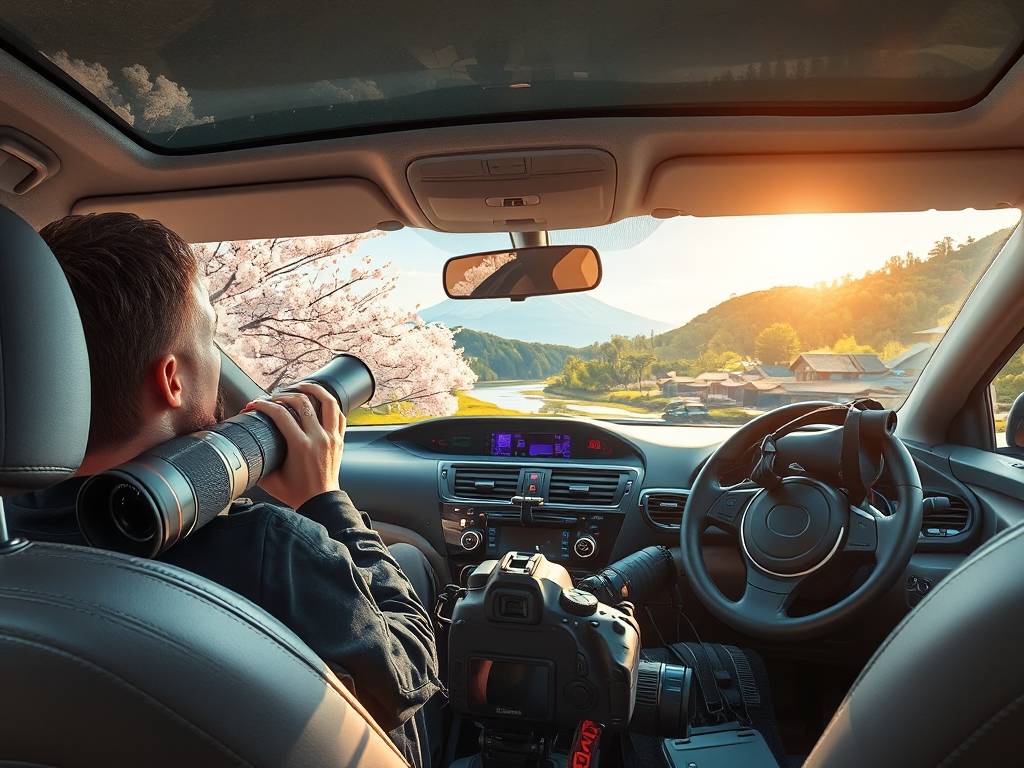Japan Travel
Japan’s Road Trip Photography Gear Reviews: Read About Camera Equipment
Capturing the Journey: An In-Depth Guide to Camera Gear for Your Japanese Road Trip
There's a unique magic to a Japanese road trip. One moment you're navigating the futuristic, neon-drenched canyons of Tokyo, and the next, you're cruising along a coastal road with views of Mount Fuji, or discovering a centuries-old temple nestled in a misty forest. For a photographer, it's a dream itinerary, but it also presents a unique set of challenges. The key to coming home with a stunning portfolio isn't just your skill; it's about having the right camera equipment that can handle this incredible diversity without weighing you down.
This guide is designed to be your one-stop resource for selecting and using the best photography gear for a Japanese road trip. We'll move beyond generic reviews and focus specifically on how different equipment performs in the contexts you'll actually encounter, from bustling cityscapes to serene rural landscapes.

The Philosophy: Versatility and Mobility
Before we dive into specific cameras and lenses, let's establish a core principle. Japan is a country of trains, compact cars, and a lot of walking. You'll be getting in and out of your vehicle constantly. A giant, heavy backpack filled with every piece of gear you own will become your enemy. The goal is a lightweight, versatile kit that covers most situations. This is the essence of smart travel photography gear selection.
1. Choosing Your Camera Body: The Heart of Your Kit
The debate between DSLR and mirrorless is largely over for travel photographers, and mirrorless cameras have taken the crown. Their compact size, lighter weight, and silent shooting modes are massive advantages.
- For the Enthusiast Road Tripper: The Sony A7 series (like the A7 III or A7 IV) is a phenomenal choice. Its full-frame sensor captures incredible detail and performs superbly in low-light situations, which is perfect for shooting night scenes in Tokyo or Osaka. Paired with good lenses, it's a workhorse. Similarly, the Fujifilm X-T series (like the X-T4 or X-T5) offers a different appeal. Their classic dial-based controls are a joy to use, and their renowned film simulations let you create beautiful JPEGs straight out of the camera, saving you editing time on the road. This is perfect for capturing the nostalgic mood of an old Kyoto street or a rural onsen town.
- For the Aspiring Photographer: Don't underestimate advanced compact cameras. The Sony RX100 series remains the king of the "pocket powerhouses." It fits in your jacket pocket, yet offers a zoom range and image quality that can rival bulkier setups. For those who want more control, micro-four-thirds systems from Olympus and Panasonic offer a huge range of tiny, high-quality lenses, making the entire kit incredibly portable for Japanese landscape photography.
Key Takeaway: A mirrorless camera, whether full-frame or APS-C, will offer the best balance of image quality, performance, and portability for your Japan photography adventure.
2. The Lenses: Your Creative Eyes
This is where your kit truly takes shape. You can't bring everything, so choose wisely. We recommend a two or three-lens setup.

- The All-Rounder Zoom: This is your workhorse lens that will likely live on your camera for 70% of the trip. A standard zoom like a 24-70mm f/2.8 or a more budget-friendly 24-105mm f/4 is perfect. It's wide enough for capturing intricate temple architecture and tight enough for candid street portraits. The constant aperture (f/2.8 or f/4) ensures you get sharp shots even as the light fades in a bamboo forest or a covered shopping arcade.
- The Wide-Angle Lens: For those breathtaking landscapes, a wide-angle lens is essential. A 16-35mm f/4 or similar will allow you to capture the vastness of the Japanese Alps in autumn or the dramatic coastline of the Noto Peninsula. It's also indispensable for shooting inside compact spaces, like the beautiful interior of a traditional ryokan.
- The Prime Lens for Low Light and Portraits: Don't leave without a fast prime lens. A 50mm f/1.8 is affordable, tiny, and magical. Its wide aperture is perfect for low light photography in Japanese izakayas, creating beautiful background blur (bokeh) in the chaotic urban jungle, and taking sharp portraits of your travel companions. It forces you to move and compose your shots more thoughtfully.
3. Essential Accessories for a Smooth Workflow
The right accessories can make or ruin a day of shooting.
- Tripod: A must-have. But size matters. A full-size tripod is impractical. Invest in a quality compact travel tripod made of carbon fiber. You'll need it for long exposures of fushimi inari shrine at night, silky water shots at waterfalls, and stable self-portraits with your rental car against a scenic backdrop.
- Filters: A circular polarizer (CPL) is your best friend. It cuts glare from water and foliage, making colors pop – essential for the vibrant fall foliage in Nikko or the brilliant blue of Okinawan waters. A neutral density (ND) filter is also great for achieving those dreamy long exposures in daylight.
- Bags and Protection: Use a discreet, comfortable camera backpack, not a bulky, obvious camera bag. Think about a weather-sealed camera bag that can handle a sudden downpour, which is common in Japan. Always carry a few microfibre cloths and lens cleaning pens to combat humidity and dust.
- Power Solutions: This is critical for a road trip. A dual battery charger for your camera is a lifesaver, allowing you to charge one battery while using the other. A high-capacity power bank can charge your camera, phone, and other devices on the go. Don't forget a car charger adapter to utilize driving time for powering up.
4. Special Considerations for the Japanese Environment
Your gear needs to survive the unique Japanese climate.
- Humidity and Rain: Japan can be incredibly humid, especially in summer. Sudden rain showers are common. Weather-sealed camera equipment is highly recommended. If your gear isn't fully sealed, keep silica gel packs in your bag and store everything in a plastic zip-lock bag with one inside your hotel room or car to prevent condensation.
- Temples and Manners: Remember that many temples and shrines have rules against using tripods indoors or in certain areas. Always be respectful, keep your gear compact, and avoid disrupting others. A silent electronic shutter is invaluable in these quiet, sacred spaces.
- Theft and Security: Japan is very safe, but it's always wise to be careful. Use bags with robust zippers and don't leave valuable gear visible in your parked car. Consider insuring your equipment before you travel.
Putting It All Together: A Sample Gear Kit
Imagine this lightweight, powerful kit for your journey:
- Camera: Fujifilm X-T5 (for its color science and compact size)
- Lenses:
- Fujifilm 16-80mm f/4 (the versatile all-rounder)
- Fujifilm 10-24mm f/4 (the wide-angle for landscapes and architecture)
- Fujifilm 35mm f/1.4 (the fast prime for low light and character)
- Accessories:
- Carbon fiber travel tripod
- Circular Polarizing Filter
- Spare batteries and a power bank
- A comfortable, weather-resistant backpack
This setup covers 99% of the scenes you'll encounter, from the vibrant cherry blossom season photography to the quiet backstreets of an ancient capital, all while being a pleasure to carry all day.
Ultimately, the best camera for your Japanese road trip is the one you have with you and know how to use. By choosing versatile, high-quality, and portable gear, you free yourself to focus on the experience and capture the unforgettable beauty of Japan. So pack smart, hit the road, and create the photographs that will tell the story of your journey for years to come.
相关文章
- Kyoto’s Traditional Shopping Gear Reviews: Read About Shopper Tools
- Japan’s Budget Accommodation Gear Reviews: Read About Travel Equipment
- Tokyo’s Transportation Gear Reviews: Read About Commuter Tools
- Japan’s Mountain Star Gazing Gear Reviews: Read About Telescope Tools
- Japan’s Traditional Tea Ceremony Gear Reviews: Read About Tea Tools
- Japan’s Summer Surf Gear Reviews: Read About Beach Equipment
- Kyoto’s Fall Foliage Gear Reviews: Read About Hiking Equipment
- Japan’s Budget Dining Gear Reviews: Read About Food Tools
- Tokyo’s Science Museum Gear Reviews: Read About Exhibit Tools
- Japan’s Island Family Beach Gear Reviews: Read About Kid Equipment
发表评论
评论列表
- 这篇文章还没有收到评论,赶紧来抢沙发吧~


